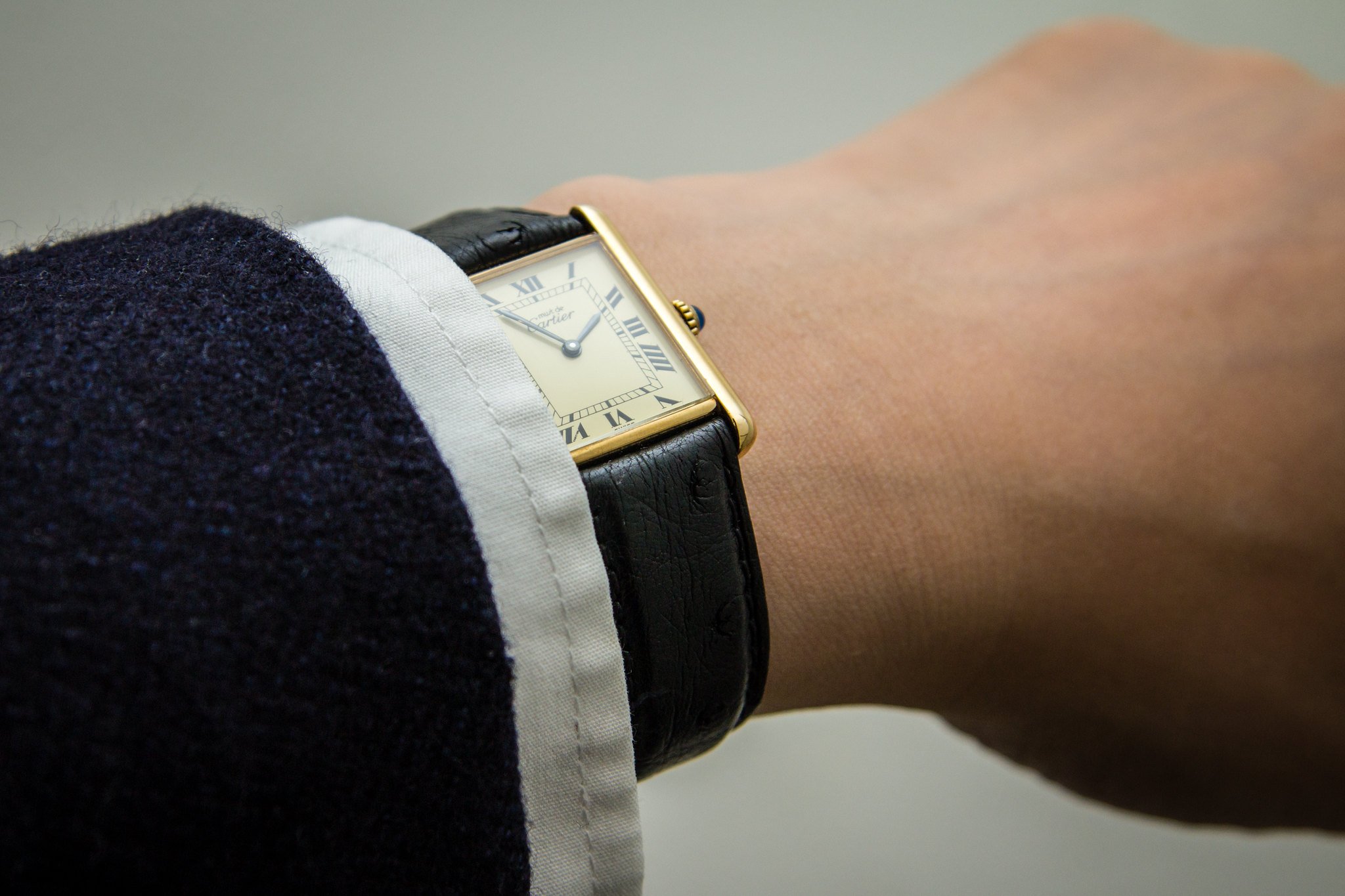Alain Delon’s passing sent me down a sartorial rabbit hole. Time and time again, I go back to the small, rectangular watch that peeked out just below the French actor’s cuffs in the 1970s. Chic, understated, and très français: a Cartier Tank.
More than a century after its creation, the Tank has become as much of a celebrity as the men who wore it. Figures like Clark Gable, Duke Ellington, Andy Warhol, and Yves Saint Laurent turned the Tank into a status symbol that’s more reserved than, say, a Rolex or Omega. (“I don’t wear a Tank to tell the time,” Warhol once said. “In fact I never wind it. I wear a Tank because it’s the watch to wear.”) Hollywood has continued its love affair with the Tank: Jacob Elordi rocked a diamond-encrusted Tank Must during the late-night circuit, and Timothée Chalamet had a limited-edition Cintrée earlier this year. Rami Malek’s becoming the face of Cartier solidified its contemporary appeal to a range of style-focused men.
But the Cartier Tank’s iconic status makes it feel like a tricky investment. It seems as though everyone has an opinion on this little watch, from what size to wear to which model to save up for. Forums, social media, and friends may give you conflicting opinions on which style is best for your needs. With that in mind, we’ve put together a comprehensive guide on the various styles, sizes, and options in the marketplace today.

Photos in this article by Guy Sie
The Cartier Tank: A Brief History
The Cartier Tank was inspired by—you guessed it—actual tanks. Louis Cartier, the brand’s founder, was inspired by the armored vehicles he saw during World War I. Cartier took the clean lines and rectangular corners of the popular Renault tanks of the day and built the first Cartier Tank in 1917. By 1919, the Tank Normale had become instantly recognizable as a testament to Cartier’s ingenuity and design language, which was perfected in the 1920s with the release of the Tank Louis Cartier. This reference included rounded corners, giving the slightest bit of softness to the overall frame of the watch.
Since the Louis, multiple varieties of Tanks have hit the market, each slightly different but still honoring the basic DNA of the early models. From the Américaine to the Solo, each model has solidified the French brand as a signifier of good taste and minimalist design.
An Overview of Tank Styles
With any brand that has a century-old archive, it can be daunting to decide which Tank is right for you. Luckily, each model is minimalistic enough to blend into your wardrobe, making for an exceptional everyday watch for those who want to add the slightest bit of je ne sais quoi to their outfit.
- Shop Cartier Tank on 1stDibs
- Shop Cartier Tank on The RealReal
Tank Louis Cartier
The Louis was the first model to branch out from the original 1919 model. With a century to be refined and perfected, the Louis is the archetypical Tank. The Louis has many features of the Tank line-up that carry through more recent models, including a rounded rectangular frame, a blue cabochon crown, blue hands, and Roman numeral indices. The Louis is still the most popular model today, as it boasts many of the features that one associates with the brand.
Tank Cintrée
Released at various times throughout the century, the Cintrée is a slender cousin to the Louis. With an elongated case, it stretches itself across the wrist, curving naturally against the bone. While vintage iterations of the Cintrée are subdued and minimalist, today’s version is a highly stylized Tank that shows the prowess of the brand’s engineering.
Tank Américaine
If you are looking for a more subdued version of the Cintrée, then the Américaine may fit the bill. Based off the Cintrée, the Américaine, too, has an elongated case but retains much of the classic features found in the Louis, such as the Roman-numeral indices, curved rectangular edges, and blue hands.
Tank Française
While the Cintrée and Américaine stretched out the proportions of the original Louis, the Française shrunk them. At first glance, you’ll notice that the defining feature of the Française is its squared body. Launched in 1996 to reinvigorate interest in Cartier’s watches, the Française has a sportier feel, largely due to its integrated bracelet, a notable departure from the house’s longstanding reliance on leather straps.
Tank Must
The Must was released in the 1970s as a more economical choice for a broader audience, and it’s been a mainstay in the line-up ever since, thanks to its simple design and attractive retail price. While similar to the Louis, which it’s modeled after, the case tends to be a bit thicker, and it’s commonly found in stainless steel. Another difference is that the Must has featured more playful colors on the dial, such as reds, greens, and vibrant yellows.

Cartier Tank Options to Consider
For those who are totally new to watches, even selecting a model can be a daunting choice. But that’s just the beginning. Here are the factors to consider when choosing the right model for you.
Movement: Quartz, Automatic, or Manual?
As a general rule, the more complicated the movement of the watch, the more expensive it will be. Quartz watches are battery-powered, giving you a watch that needs minimal care. An automatic watch will use the motion of the wearer’s wrist to wind itself using a small rotor that generates the necessary power to stay ticking. And finally, a manual watch requires the wearer to wind the watch by hand at the crown to produce the necessary power reserve to keep the watch in motion.
Bracelet or Strap?
In the past, the Française was the model most associated with an integrated steel bracelet, but today most models are fitted with one, including the Must and Américaine. Expect to pay slightly more for a bracelet.
Size: Is XL Too Large?
I saved the hardest for last: choosing the size of your Tank. Today, the watch industry is built on the adage of “the bigger the better”—but this is quickly changing. More guys are discovering the elegance of smaller models.
“I have a plea to all horology-loving men: Add a small watch to your collection,” writes our own Karlton Miko Tyack. “They show that you don’t need to peacock, that you have nothing to compensate for.”
As Zach Kazan, managing editor at Worn & Wound, puts it, “For years, the most popular styles have been some variety of large sports watches, and inspired by past references from the ’50s, ’60s, or ’70s. The rising popularity of the Tanks show that the pendulum is swinging to something more refined and compact, as many collectors are stepping away from the oversized models in the marketplace today.”
Because of this, our Tank-buying advice is resounding: go small. Tanks are meant to be subtle, which can be a bit incongruous to many people’s thinking when it comes to buying a luxury item. The rectangular case is going to appear larger than a round watch, so you should consider the proportionality of a smaller watch as more complementary to a larger one. I highly recommend that for a man’s wrist size (which averages between 6.5 to 7.5 inches), going for a medium size is your best bet. A large can work, but if you go with a Cintrée or Américaine model, it will appear to be more a bangle than a timepiece. When in doubt, try to go to a Cartier retailer and see in-person the varying sizes of Tanks available; you’d be surprised how many customers opt for the subtlety of a smaller watch when they see how ostentatious the XL feels.
Where to Buy a Cartier Tank
If you’re planning to buy a Tank, it’s best to go with a reputable dealer. Going directly to Cartier’s site is the most expedient way to get what you want. If you’d like to see a watch in person, look for what is called an authorized dealer in your area. These will be companies—usually jewelry stores—which have been vetted to sell Cartier, working directly with the brand.
Alternatively, you can go second-hand. The resale market on Cartier is competitive, but you can find an endless supply of options on watch resale sites like Chrono24 and Crown & Caliber. These sites are generally trustworthy and have loads of security measures set up to ensure that someone isn’t selling you a fake. Many also offer payment plans if you need to finance.
Finally, nontraditional second-hand shops can be a great alternative if you’ve exhausted other options. There is the behemoth, eBay, which many watch collectors swear by. Of course, there is always a risk here, so be sure to research the store, read other customer reviews, and read through eBay’s buyer protection; we also recommend filtering results by “Authenticity Guarantee.” I got my first Tank at The RealReal. The fashion reseller offers preowned Tanks at a discount; they’re vetted by professionals and come with an in-house grading system so you know about any cosmetic or mechanical errors.
- Shop Cartier Tank on 1stDibs
- Shop Cartier Tank on The RealReal

Final Thoughts on the Cartier Tank
When it comes right down to it, a Cartier Tank is as much about heritage as it is about design. When wearing a Tank, you’re buying into a century-long design legacy, appreciated by everyone from French actors to First Ladies. But not just that, the minimal design can balance out an outfit, never competing with it. It makes for a great everyday watch that feels as special as it looks. And, sure, you can easily pick up a Seiko Tank tribute or invest in a similarly shaped Longines Dolcevita, but for me, there’s something missing when putting on a lookalike. While those that do it first don’t always do it better, it’s hard to deny that Cartier has been perfecting their Tanks over the last hundred years, creating a watch that will never go out of style.
More Watches

Good, Better, Bezel: How G-SHOCK’s G-STEEL Keeps Toughening Up Beauty
The brand that invented unbreakable style just made its two most iconic watches even sharper.

The Somms of Watches: I’m Timepiece Certified and You Could Be, Too
Coolest resolution, unlocked.

Sheffield Revives a Classic: Crafting Quality, Technology, and Affordability Into Every Timepiece
The microbrand making watches the old-fashioned way. By overdelivering.

